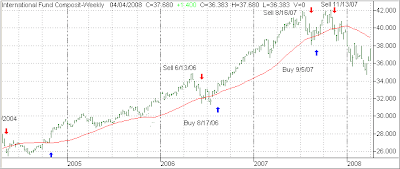 Income investors looking for a higher yield are having a tough time since high yield equals high risk. Bloomberg reports that “Junk Bond Losses Top $35 Billion.” Here are some highlights:
Income investors looking for a higher yield are having a tough time since high yield equals high risk. Bloomberg reports that “Junk Bond Losses Top $35 Billion.” Here are some highlights:
High-yield, high-risk bonds are off to their worst start ever, and the biggest investors say there’s no recovery in sight.
Junk bonds have fallen an average 3.9 percent this year, losing about $35 billion, according to data from Merrill Lynch & Co. indexes. Some funds managed by John Hancock Advisers LLC, OppenheimerFunds Inc. and Fidelity Investments are down more than 7 percent, showing that even the largest investors were caught off guard by the collapse.
While the Federal Reserve has slashed benchmark interest rates by 3 percentage points since September, it has been unable to get investors to increase their purchases of the riskiest assets. The declines are choking off financing for speculative- grade companies, boosting defaults. The debt is likely to “struggle” for months as the economy enters a recession, according to JP Morgan Securities Inc., the top high-yield research firm in Institutional Investor magazine’s annual poll.
“The moves have been absolutely vicious,” said Arthur Calavritinos, whose $1.2 billion John Hancock High Yield Fund has lost about 9.8 percent since December. The Boston-based manager said it’s the worst market since he started in finance in 1985.
…
Investors are demanding yields averaging 8.07 percentage points more than Treasuries, up from 5.92 percentage points at the end of last year, and a record low of 2.41 percentage points in June, index data from New York-based Merrill show. The spread reached 8.62 percentage points on March 17, the most since 2003.
…
Moody’s said the default rate climbed to 1.3 percent last month from 0.9 percent in December, after Quebecor World Inc., a Montreal-based printing company, and Buffets Holdings Inc., an Eagan, Minnesota-based restaurant chain, filed for bankruptcy. The New York-based credit-rating company raised its forecast this month to 5.4 percent from 4.6 percent by yearend.
Every industry group except energy and utilities posted negative returns this year. Bonds of finance companies lost 20 percent; media bonds, 10.2 percent; and real estate securities, 9.9 percent, Merrill index data show.
…
John Hancock, OppenheimerFunds and Fidelity, managers of three of the worst performing high-yield debt funds this year, own R.H. Donnelley Corp., the U.S. publisher of phone directories, regulatory filings show.
The Cary, North Carolina-based company’s bonds plunged 24 percent in February, more than all but one other top-50 issuer in the high-yield market, according to Merrill index data.
…
The $3.4 billion Fidelity Advisor High Income Advantage Fund, which invests in high-yield bonds, preferred shares and convertible securities rated below investment grade, lost 7.52 percent this year. The $2.1 billion Oppenheimer Champion Income Fund, which mainly buys high-yield debt, has tumbled 13.1 percent.
The lesson here is that junk is junk. In today’s environment, it simply does not pay to take chances on getting a high yield and then seeing your principal drop precipitously. As I said before, if you need income, use a combination approach of selecting no load mutual funds/ETFs with acceptable dividends, but make sure that they are trending up.
How can you do that? Look at my weekly updated StatSheet, section 10 on Bond and Dividend paying ETFs, and examine those with a positive %M/A, which means closing prices are above their long-term trend lines. Click here to view the latest issue. Then use your favorite financial site to see what the current dividend payout is.
 The Fed released it March 18 FOMC minutes, and it was revealed that many Fed officials were of the opinion that an economic contraction was “likely.” This is not earthshaking news especially in view of the fact that Fed Chairman Bernanke has since uttered the “R-Word.”
The Fed released it March 18 FOMC minutes, and it was revealed that many Fed officials were of the opinion that an economic contraction was “likely.” This is not earthshaking news especially in view of the fact that Fed Chairman Bernanke has since uttered the “R-Word.” 





